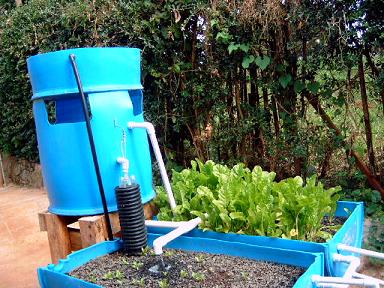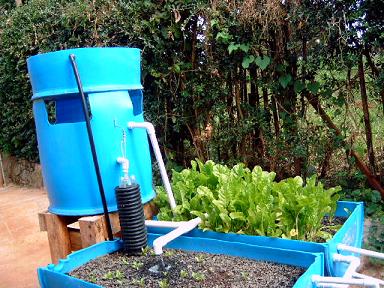Last year, thanks in large part to the White House kitchen garden, the country saw a resurgence in interest in backyard gardening. But this being America, where one-upsmanship sometimes seems like a national pastime, the vanguard has apparently moved on … to “aquaponics.” The New York Times illustrates what makes this “breeding edge” of backyard agriculture different with a visit to hobby farmer Rob Torcellini’s hand-built installation in Connecticut:
There are fish here, for one thing, shivering through the winter, and a jerry-built system of tanks, heaters, pumps, pipes, and gravel beds. The greenhouse vents run on a $20 pair of recycled windshield wiper motors, and a thermostat system sends Mr. Torcellini email alerts when the temperature drops below 36 degrees. Some 500 gallons of water fill a pair of food-grade polyethylene drums that he scavenged from a light-industry park.
… What feeds his winter crop of lettuce is recirculating water from the 150-gallon fish tank and the waste generated by his 20 jumbo goldfish. Wastewater is what fertilizes the 27 strawberry plants from last summer, too. They occupy little cubbies in a seven-foot-tall PVC pipe. When the temperature begins to climb in the spring, he will plant the rest of the gravel containers with beans, peppers, tomatoes, and cucumbers — all the things many other gardeners grow outside.
In here, though, the yields are otherworldly. “We actually kept a tally of how many cherry tomatoes we grew,” Mr. Torcellini said of last summer’s crop. “And from one plant, it was 347.” A trio of cucumber plants threw off 175 cukes.
 “Barrel-ponic” gardening system in Kenya.Photo: Travis HugheyIf this sounds familiar, it should. Urban ag pioneer Will Allen has built a thriving commercial and philanthropic endeavor on exactly this kind of setup. But to see an individual put something like this together is a fish of another color. Granted, this is for the most passionate among us, but it’s not necessarily budget-busting. In fact, you can pick up a small aquaponics kit on Amazon starting at $300. Or you can go for it and get aquaponics expert Travis Hughey’s “Barrel-ponics” system for a bit more (the NYT claims he will soon start selling fully assembled systems for about $500).
“Barrel-ponic” gardening system in Kenya.Photo: Travis HugheyIf this sounds familiar, it should. Urban ag pioneer Will Allen has built a thriving commercial and philanthropic endeavor on exactly this kind of setup. But to see an individual put something like this together is a fish of another color. Granted, this is for the most passionate among us, but it’s not necessarily budget-busting. In fact, you can pick up a small aquaponics kit on Amazon starting at $300. Or you can go for it and get aquaponics expert Travis Hughey’s “Barrel-ponics” system for a bit more (the NYT claims he will soon start selling fully assembled systems for about $500).
Obviously, this isn’t for everyone, or even most of us. But judging from the potential productivity from these home farmers, whole neighborhoods could benefit from having just one committed aquaponics farmer around. So, who’s up for a bit of fish farming?



